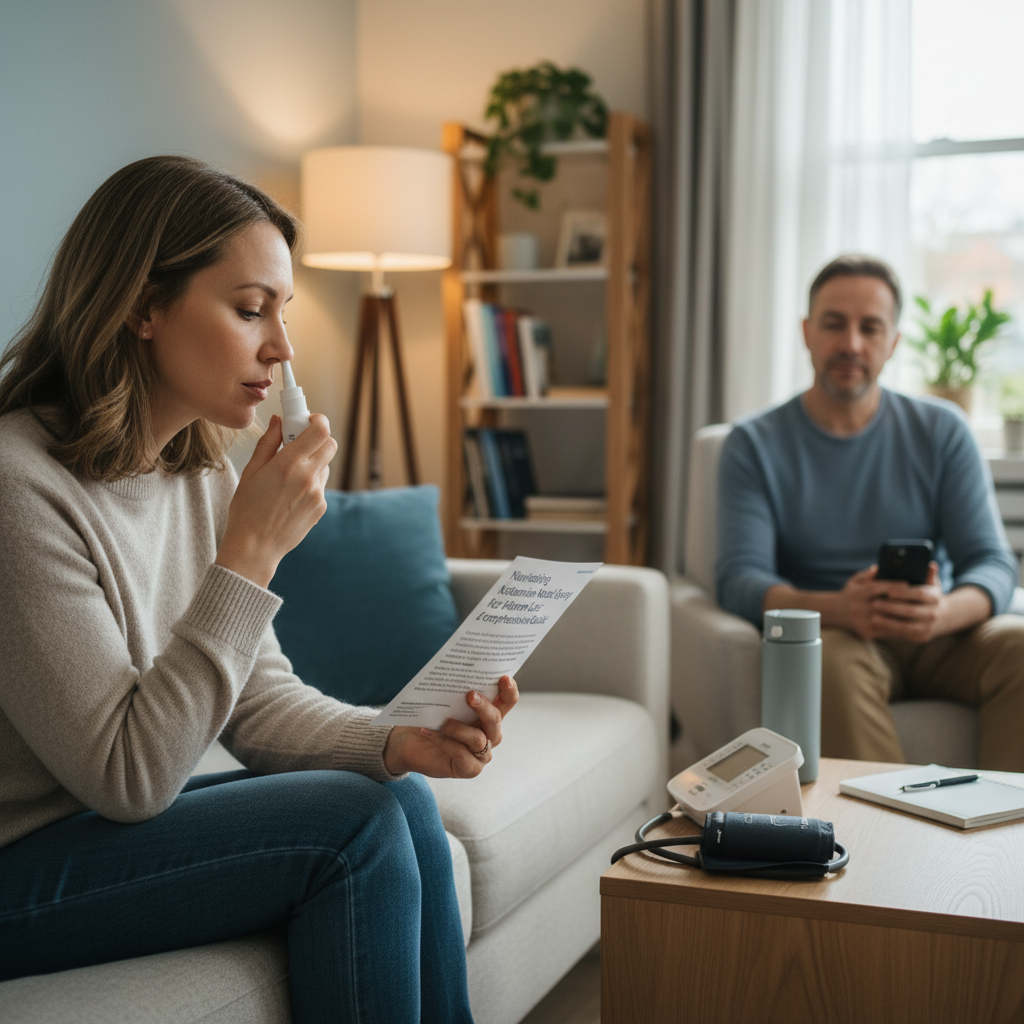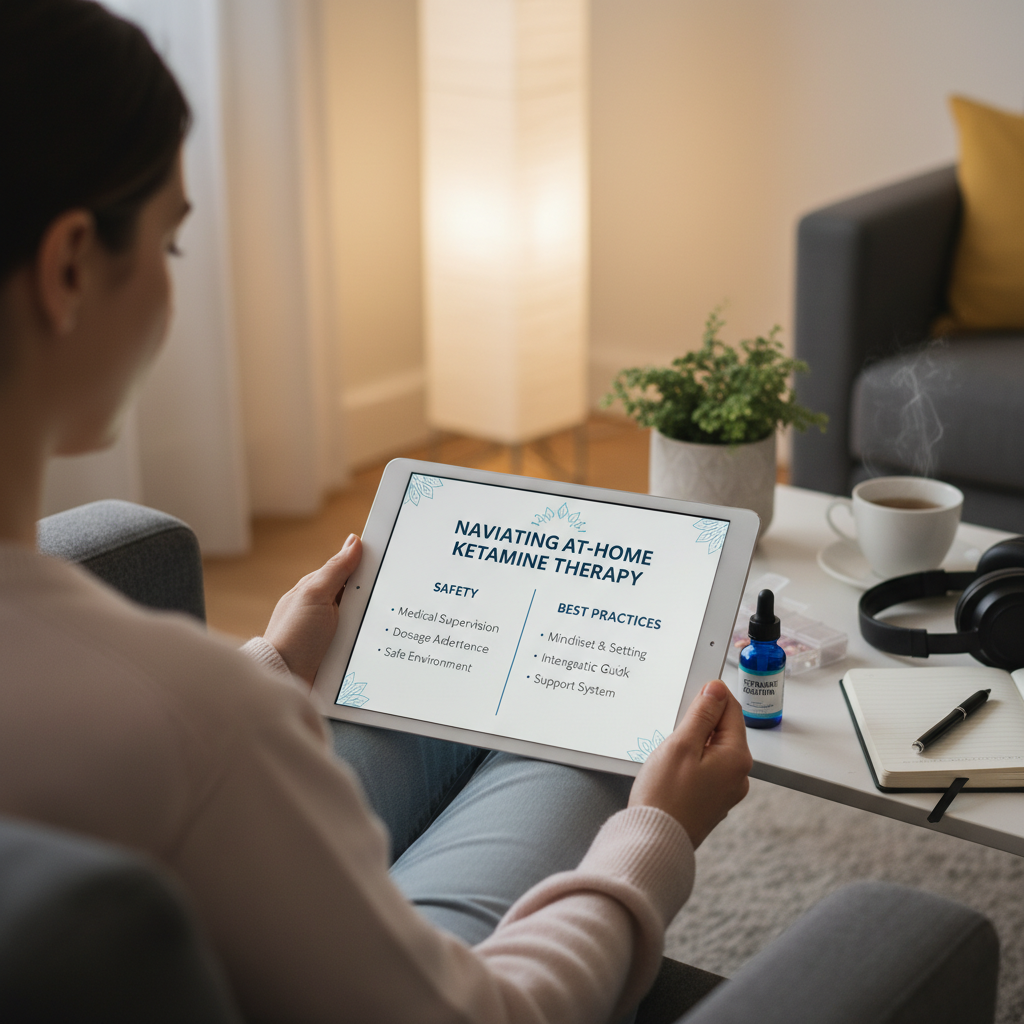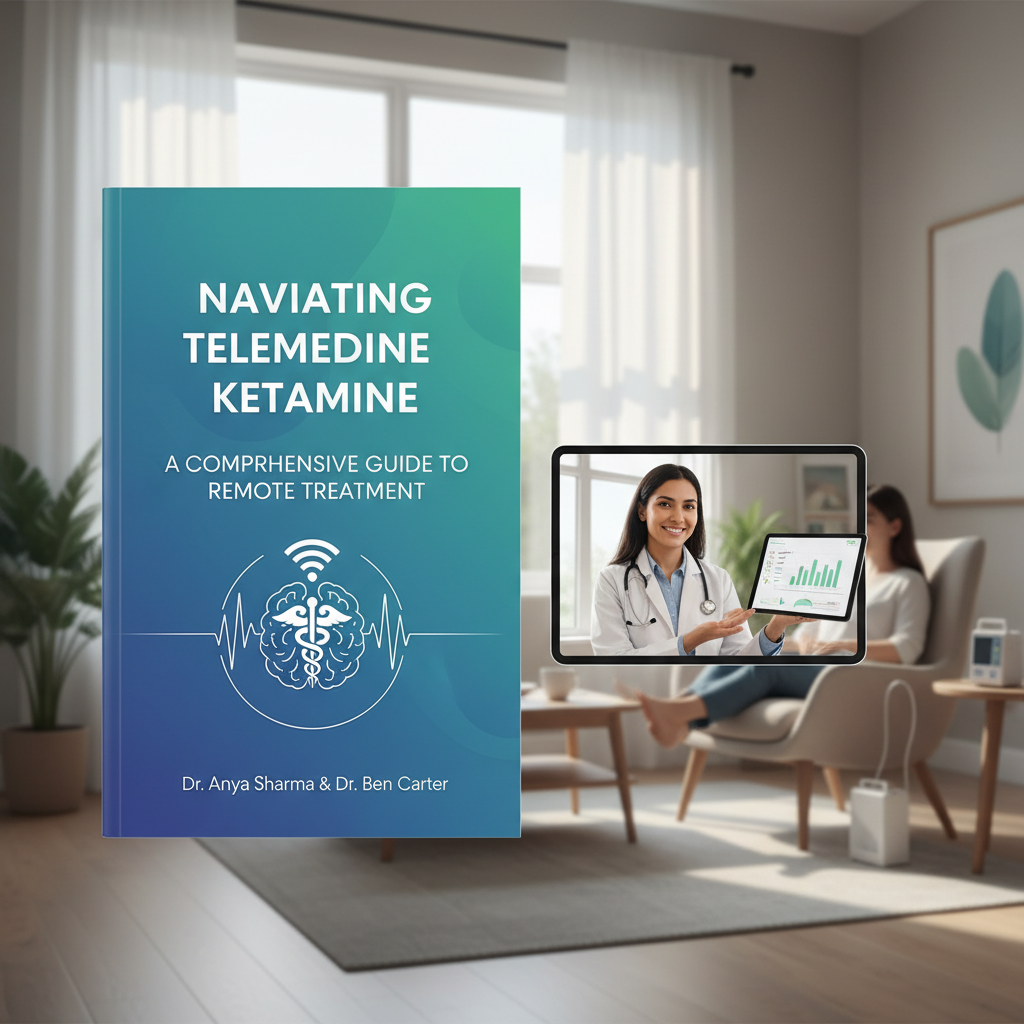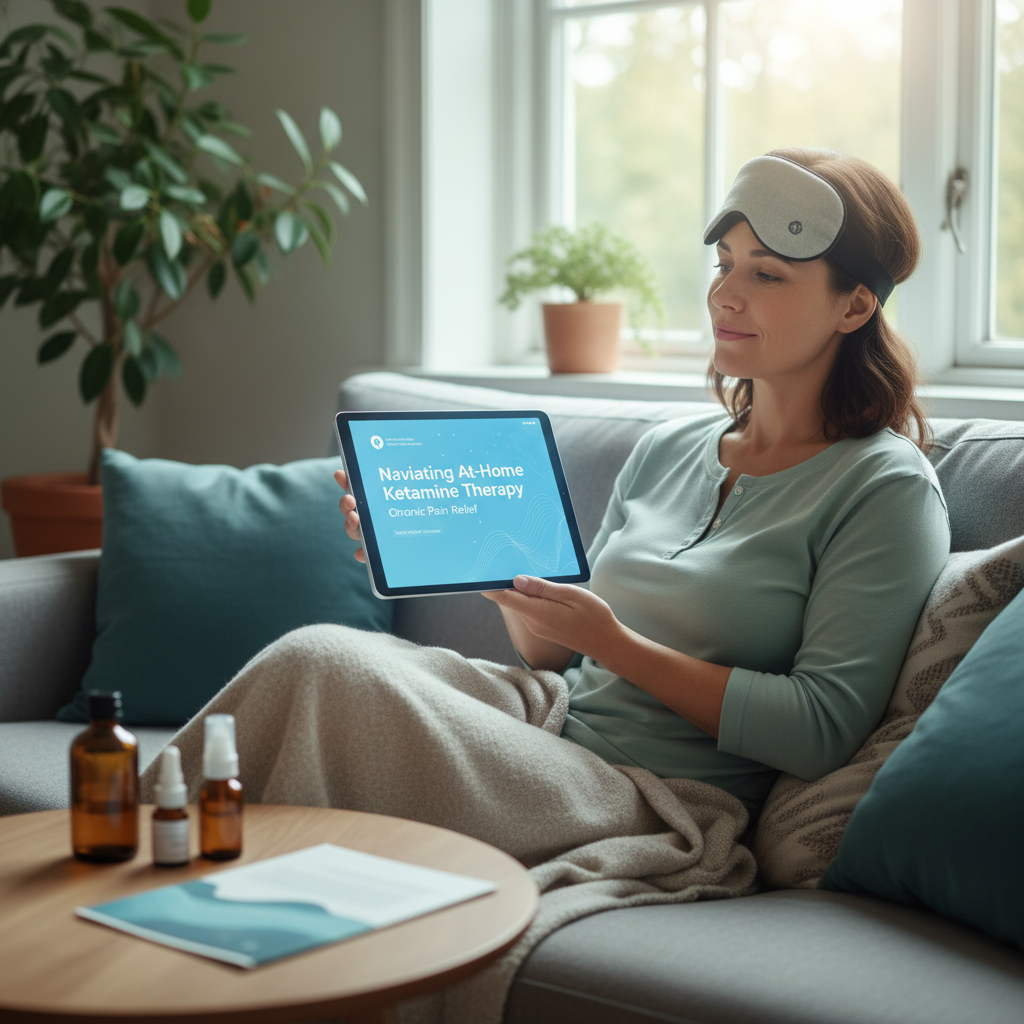Understanding Safety, Efficacy, and Logistics for At-Home Treatment
Quick Summary / Key Takeaways
- Ketamine nasal spray for home use is a medically supervised treatment for severe depression or PTSD, requiring strict protocols and regular monitoring.
- Patient selection is crucial, involving thorough psychiatric evaluation to ensure suitability and minimize risks in an unsupervised setting.
- Dosage, administration, and emergency preparedness are meticulously managed by healthcare providers to ensure patient safety at home.
- While offering convenience, home use demands significant patient responsibility and adherence to detailed instructions for optimal outcomes.
- Potential side effects and contraindications necessitate ongoing communication with the treatment team and access to support systems.
Introduction
Ketamine, once primarily an anesthetic, has emerged as a groundbreaking treatment for severe depression and PTSD, particularly in its nasal spray form. While often administered in a clinic, the landscape is evolving, and for some, medically supervised at-home use of compounded ketamine nasal spray is becoming a viable, albeit carefully orchestrated, option. This shift offers unparalleled convenience, yet it introduces a unique set of responsibilities and considerations for both patients and providers. Navigating the complexities of ketamine nasal spray home use requires a deep understanding of its mechanisms, safety protocols, and the critical role of a robust support system. This isn’t a DIY solution; it’s a specialized medical treatment requiring constant oversight, emphasizing patient education and adherence to strict guidelines. My experience in this field has shown me that informed patients are safer patients, capable of maximizing therapeutic benefits while mitigating potential risks. This guide will demystify the process, offering a clear, authoritative pathway through the journey of at-home ketamine therapy. We’ll explore who is a suitable candidate, what to expect during treatment, and how to ensure a safe and effective experience right from your living room.
Key Differences: In-Clinic vs. At-Home Ketamine Nasal Spray
| Aspect | In-Clinic (Spravato) | At-Home (Compounded) | Key Consideration |
|---|---|---|---|
| Supervision Level | Direct observation by clinician | Remote monitoring, patient self-administers | Patient responsibility is higher |
| Drug Form | FDA-approved esketamine | Compounded ketamine racemic mix | Regulatory oversight varies |
| Environment | Controlled medical setting | Familiar home environment | Comfort vs. immediate support |
| Cost/Insurance | Often covered by insurance | Typically out-of-pocket | Financial planning essential |
Ketamine Nasal Spray Home Use: Eligibility & Exclusions
| Criteria Type | Eligible Patients | Excluded Patients | Rationale |
|---|---|---|---|
| Diagnosis | Treatment-resistant depression (TRD) | Untreated psychosis, active mania | Risk of exacerbating symptoms |
| Medical History | Stable cardiovascular health | Uncontrolled hypertension, aneurysm | Cardiovascular risk during treatment |
| Support System | Reliable caregiver present | Lives alone with no local support | Safety in case of adverse events |
| Adherence | Demonstrated treatment compliance | History of substance misuse | Risk of diversion or misuse |
Application Preparation Checklist
- Complete medical and psychiatric evaluation with your prescribing clinician.
- Attend comprehensive training on proper nasal spray administration.
- Establish a dedicated, safe home environment for treatment sessions.
- Confirm caregiver availability and emergency contact protocols.
Post-Arrival Checklist
- Adhere strictly to prescribed dosage and schedule; do not self-adjust.
- Maintain open communication with your treatment team regarding effects.
- Regularly track mood, side effects, and treatment efficacy in a journal.
- Safely store medication and dispose of used supplies per instructions.
Table of Contents
Section 1: Understanding Ketamine Nasal Spray for Home Use
- What is ketamine nasal spray for home use?
- How does ketamine nasal spray work for mental health conditions?
- Is at-home ketamine nasal spray the same as Spravato?
- What mental health conditions can it treat?
- What are the potential benefits of home administration?
Section 2: Eligibility and Preparation
- Who is a suitable candidate for home ketamine nasal spray?
- What medical conditions preclude home use?
- What kind of supervision is required for home treatment?
- How should I prepare my home environment for a session?
- What role does a caregiver play during home sessions?
Section 3: Safety, Administration & Ongoing Management
- What are the typical steps for administering the nasal spray at home?
- What side effects might I experience during or after a home session?
- How are emergency situations handled during home treatment?
- What is the long-term commitment for ketamine nasal spray home use?
- How do I track progress and communicate with my care team?
Frequently Asked Questions
Section 1: Understanding Ketamine Nasal Spray for Home Use
FAQ 1: What is ketamine nasal spray for home use?
Ketamine nasal spray for home use is a prescribed, compounded form of ketamine administered by the patient in their residence under strict medical supervision and remote monitoring. It’s typically prescribed for severe, treatment-resistant mental health conditions when traditional therapies have failed. This approach aims to provide greater convenience and accessibility while maintaining essential safety protocols. Patients receive detailed instructions and support to ensure appropriate and safe administration in a non-clinical setting.
FAQ 2: How does ketamine nasal spray work for mental health conditions?
Ketamine works rapidly by modulating glutamate, an important neurotransmitter in the brain, to create new neural pathways and improve synaptic plasticity, which can quickly alleviate severe depressive symptoms. Unlike traditional antidepressants, which often target serotonin or norepinephrine and take weeks to show effect, ketamine acts on the NMDA receptors. This action can lead to a rapid reduction in symptoms, fostering a more positive outlook and cognitive flexibility. Its unique mechanism helps “reset” the brain’s maladaptive patterns associated with chronic depression.
FAQ 3: Is at-home ketamine nasal spray the same as Spravato?
No, at-home ketamine nasal spray is typically a compounded racemic ketamine, whereas Spravato (esketamine) is an FDA-approved single isomer form of ketamine, usually administered in a certified clinic under direct observation. Spravato is specifically approved for treatment-resistant depression (TRD) and depressive symptoms in adults with Major Depressive Disorder (MDD) with acute suicidal ideation or behavior. Compounded ketamine offers a broader application but lacks FDA approval for specific mental health indications. The regulatory and oversight frameworks differ significantly between the two.
FAQ 4: What mental health conditions can it treat?
While the FDA-approved esketamine (Spravato) targets treatment-resistant depression (TRD) and MDD with acute suicidal ideation, compounded ketamine nasal spray is often prescribed off-label for similar conditions, as well as PTSD, anxiety disorders, and chronic pain syndromes. Its rapid antidepressant and anxiolytic effects make it a valuable option for conditions that have not responded to conventional treatments. However, its use for these conditions requires careful evaluation and a clear treatment plan from a qualified physician. Always consult a healthcare professional for specific diagnosis and treatment advice.
FAQ 5: What are the potential benefits of home administration?
The primary benefits of home administration include increased convenience, privacy, and reduced logistical burdens associated with frequent clinic visits, making treatment more accessible for eligible patients. This approach allows individuals to receive therapy in a comfortable, familiar environment, which can enhance the therapeutic experience and reduce anxiety. It also eliminates travel time and costs, integrating treatment more seamlessly into daily life. However, these benefits are balanced by the heightened need for patient responsibility and a strong support system.
Section 2: Eligibility and Preparation
FAQ 6: Who is a suitable candidate for home ketamine nasal spray?
Suitable candidates are adults with severe, treatment-resistant depression (TRD) or similar conditions, displaying a stable health profile and clear medical necessity. They require a reliable support system, a safe home environment, and capacity to strictly follow protocols. A comprehensive medical and psychiatric evaluation, including cardiovascular health, is mandatory to rule out contraindications. Patients must commit to ongoing communication with their treatment team for optimal safety and efficacy at home.
FAQ 7: What medical conditions preclude home use?
Certain medical conditions, such as uncontrolled hypertension, severe cardiovascular disease (e.g., history of aneurysm, stroke), untreated thyroid disorders, active psychosis, mania, or a history of substance abuse, typically preclude home use due to safety risks. Patients with unstable respiratory conditions or severe liver impairment are also often deemed unsuitable because ketamine can transiently affect these systems. These conditions increase the risk of adverse events that require immediate medical intervention, making an unsupervised home setting unsafe.
FAQ 8: What kind of supervision is required for home treatment?
Home treatment requires remote medical supervision, typically involving telehealth consultations, a dedicated caregiver present during sessions, and readily accessible emergency contact information. While direct physical observation isn’t continuous, the medical team monitors treatment progress, side effects, and adherence through regular check-ins and patient-reported data. The caregiver plays a vital role in ensuring patient safety, observing for adverse reactions, and providing support throughout the session. This collaborative model ensures safety while leveraging the convenience of home.
FAQ 9: How should I prepare my home environment for a session?
Preparing your home environment involves creating a quiet, comfortable, and distraction-free space where you can safely relax for the duration of the treatment and recovery period. This includes dimming lights, minimizing noise, and ensuring you have access to a comfortable reclining chair or bed. It is essential to remove any potential hazards, secure pets, and ensure privacy. Having water, a blanket, and a trusted caregiver nearby are also critical components for a safe and therapeutic experience.
FAQ 10: What role does a caregiver play during home sessions?
A caregiver’s role is critical during home ketamine sessions, primarily focused on ensuring patient safety, monitoring for side effects, and providing emotional support. They are responsible for observing the patient for any concerning reactions, assisting if the patient needs help, and being prepared to contact emergency services if necessary. The caregiver should be a trusted adult who is sober, alert, and fully trained in emergency protocols, acting as an extra layer of vigilance in the absence of a medical professional.
Section 3: Safety, Administration & Ongoing Management
FAQ 11: What are the typical steps for administering the nasal spray at home?
Administration typically involves clearing nasal passages, reclining comfortably, and then following precise instructions to spray the medication into each nostril as directed by your clinician, ensuring proper absorption. After spraying, it’s crucial to avoid sniffing or swallowing and to remain reclined for a specific period to maximize absorption and minimize side effects. Patients receive detailed, individualized instructions on dosage, timing, and post-administration recovery protocols. Always refer to your specific prescription and the training provided by your medical team.
FAQ 12: What side effects might I experience during or after a home session?
Common side effects during or immediately after a session include temporary dissociation, dizziness, nausea, elevated blood pressure, and blurred vision, which typically subside within 60-90 minutes. These effects are usually mild to moderate and are part of the expected pharmacological action of ketamine. Patients are instructed to remain in a safe, supervised environment until these effects resolve, typically for at least two hours. Open communication with your care team about any persistent or severe side effects is crucial.
FAQ 13: How are emergency situations handled during home treatment?
Emergency protocols involve immediate contact with the prescribing clinician or emergency services (911/local equivalent), with caregivers trained for decisive action. Patients and caregivers receive clear instructions on identifying severe adverse reactions. This includes extreme hypertension, prolonged unconsciousness, or respiratory distress. These strict protocols ensure rapid medical help if a critical event occurs during home treatment.
FAQ 14: What is the long-term commitment for ketamine nasal spray home use?
Long-term commitment typically involves an initial induction phase with frequent treatments, followed by a maintenance phase with reduced frequency based on individual response. This duration varies, from several months to ongoing therapy, depending on patient need and sustained efficacy. Regular follow-up appointments with the prescribing physician are essential to monitor progress and adjust dosages. It is a commitment to consistent therapy and medical oversight for sustained benefits.
FAQ 15: How do I track progress and communicate with my care team?
Tracking progress involves regularly documenting mood changes, symptom severity, side effects, and overall well-being in a journal or through provided assessment tools. Effective communication with your care team is maintained through scheduled telehealth appointments and secure messaging platforms. Sharing detailed observations and any concerns allows your clinician to make informed adjustments to your treatment plan. This open dialogue ensures the therapy remains effective and safe throughout its duration, optimizing outcomes.






